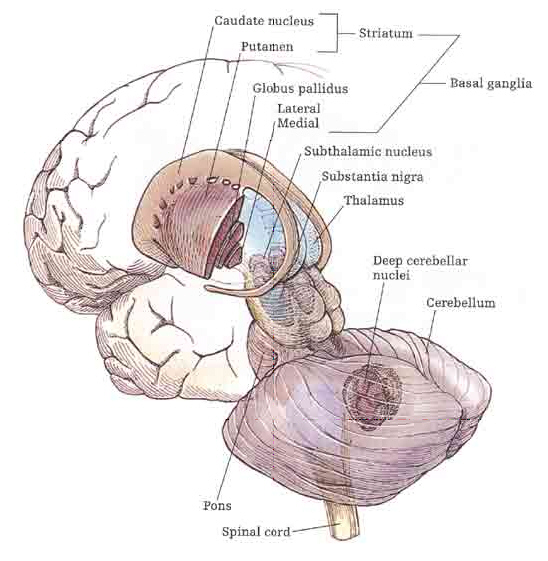Basal ganglia
From Psy3242
| Line 6: | Line 6: | ||
[[image:Basalganglia.jpeg]] | [[image:Basalganglia.jpeg]] | ||
| + | |||
| + | Pronunciation: ( ba¢sal gang¢le-a) Large masses of gray matter at the base of the cerebral hemisphere: the striate body (caudate and lentiform nuclei) and cell groups associated with the striate body, such as the subthalamic nucleus and substantia nigra. | ||
Revision as of 21:11, 9 April 2008
The basal ganglia is a motor control region. The basal ganglia interacts with the cortex. In Parkinson's Disease, the basal ganglia is the structure that breaks down. Some people with basal ganglia damage sometimes have "writhing" like movements or other postural disturbances. The basal ganglia comprises several interconnected structures such as the caudate, putamen, globus pallidus, and substantia nigra. The basal ganglia in combination with the motor cortex determine which possible actions actually get put into effect by permitting some and inhibiting others. Researchers now think that the basal ganglia serve as a sort of gatekeeper for motor plans that originate in the cortex, and damage to any of the component structures will impair the cordination or control of movement.
The basal ganglia is paired groups of subcortical nuclei(or ganglia) that lie deep in the brain at the base of each cerebral hemisphere, and the thalamus--also paired groups of mulitiple nuclei that lie on either side of the third ventricle at the anterior end of the brainstem. The basal ganglia in each hemisphere include the caudate and the putamen (together called the corpus striatum), the globus pallidus, the substantia nigra, and the subthalamic nucleus (STN). There are multiple pathways or circuits connecting the various nuclei of the basal ganglia, thalamus and cortex.
Pronunciation: ( ba¢sal gang¢le-a) Large masses of gray matter at the base of the cerebral hemisphere: the striate body (caudate and lentiform nuclei) and cell groups associated with the striate body, such as the subthalamic nucleus and substantia nigra.

